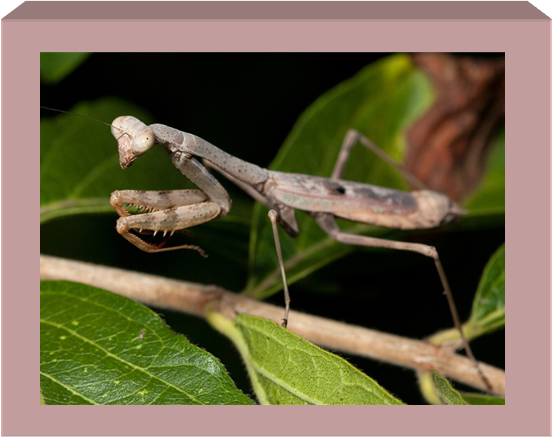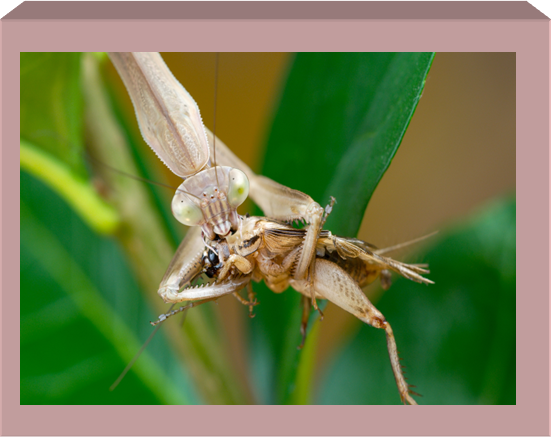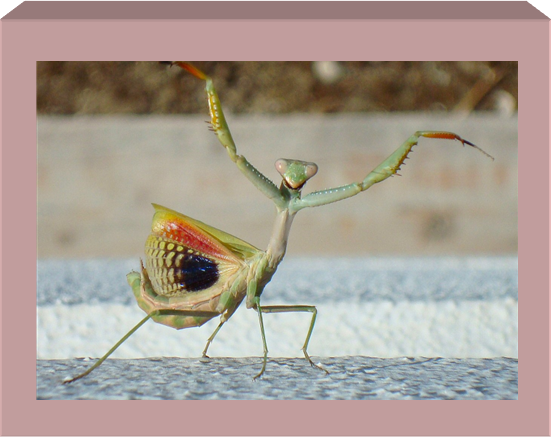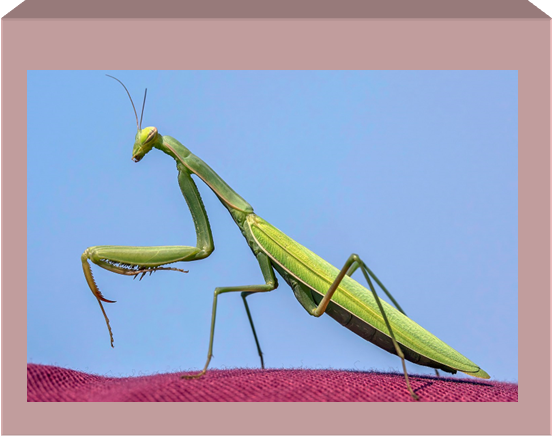
VIEW ON NATURE
Let Us Prey
By: Stephen L. Wendt
 Adult female Carolina mantis
Adult female Carolina mantis
Mother Nature must have been very fond of insects when creating Virginia because there are more than 20,000 species of bugs and bug-like creatures living across the Old Dominion. And of all of those, about 10 percent or 2,100 species are deemed beneficial bugs. And in my book, the king of the beneficial insects is the praying mantis.
The Praying mantis is a strong, patient hunter. It can wait motionless for long periods of time until a clueless victim wanders within reach. And within reach is the name of the mantis game.
Careful observation reveals that the mantis lies in wait until it can reach out and imperceptibly touch its prey with both of its long, super-thin antennae; the moment it touches with both, the mantis quick-as-lightning strikes to grasp its prey in both spiked forearms. Once in hold, the otherworldly mantis mechanically devours its prey with its strong jaws. To us, they are harmless, do not sting, and have no venom.
The completely carnivorous mantis is the ultimate patient predator with its camouflage appearance and sole, unique ability to swivel its head at extreme angles while using its excellent binocular vison to hone in on victims. Adding to its invincibility is a defensive hearing adaptation in the middle of its thorax. This auditory organ evolved to detect bat echolocation waves, its main predator, enables flying mantises to respond evasively. So, when you see a mantis on a night flight suddenly dive downward, he’s proactively avoiding an incoming bat like a fighter pilot.
Mantises are infamous for their cannibalism, especially the female’s habit of decapitating her much smaller suitor after (or even before) mating, and then entirely consuming him afterwards. I’ve seen a large female mantis completely consume two males within her reach in a matter of five minutes!
Praying mantises’ enormous appetites, tendency to stay put/ not wander, and highly effective hunting methods make them a recognized Earth-friendly alternative to chemical insecticides. You name, it, they will eat just about any insect, from grasshoppers and beetles to caterpillars, flies, and other large and small insect pests. As such, their egg masses are sold at some garden stores for seeding gardens with these beneficial hunters. Given their cannibalistic ways, they also control their own numbers.
There are three species of mantises in Virginia – the Chinese, European, and Carolina mantises. The European and Chinese are larger (4 to 5 inches long) and considered invasive and less desired species because they’re not native and eat beneficial insects like butterflies and bees. You can easily identify the Carolina mantis because it is three inches in length and can range in color from green to dusky brown to grey.
I’ve always been fascinated by praying mantises being the ultimate predator with such excellent vision. I always remember how a large female I kept as a pet in an aquarium would cock its head at me from across the room when I would get up from my chair. Let’s just be glad they are not six feet long.
Reproduction of any article or photograph requires the written permission of the
The ENDEAVOR News Magazine. Unless otherwise noted, photographs are courtesy of the Annandale Chamber of Commerce photographic archive, Wikipedia, and private collections with all rights reserved.
(Copyright © 2012 Annandale Chamber of Commerce. All rights reserved. (Photographs & images, on this page, and on this website, are not available for use by other publications, blogs, individuals, websites, or social media sites.)
 "Tenodera sinensis" Chinese mantis
"Tenodera sinensis" Chinese mantis
Luc Viatour / https://Lucnix.be

Adult female Iris oratoria performs a bluffing threat display, rearing back with the forelegs and wings spread and mouth opened.
Creative Commons Attribution-Share Alike 3.0 Unported

European praying mantis
(Mantis religiosa) green female
(Copyright © 2012 Annandale Chamber of Commerce. All rights reserved. (Photographs & images, on this page, and on this website, are not available for use by other publications, blogs, individuals, websites, or social media sites.)
Copyright 2012 Annandale Chamber of Commerce. All rights reserved. Privacy Policy

